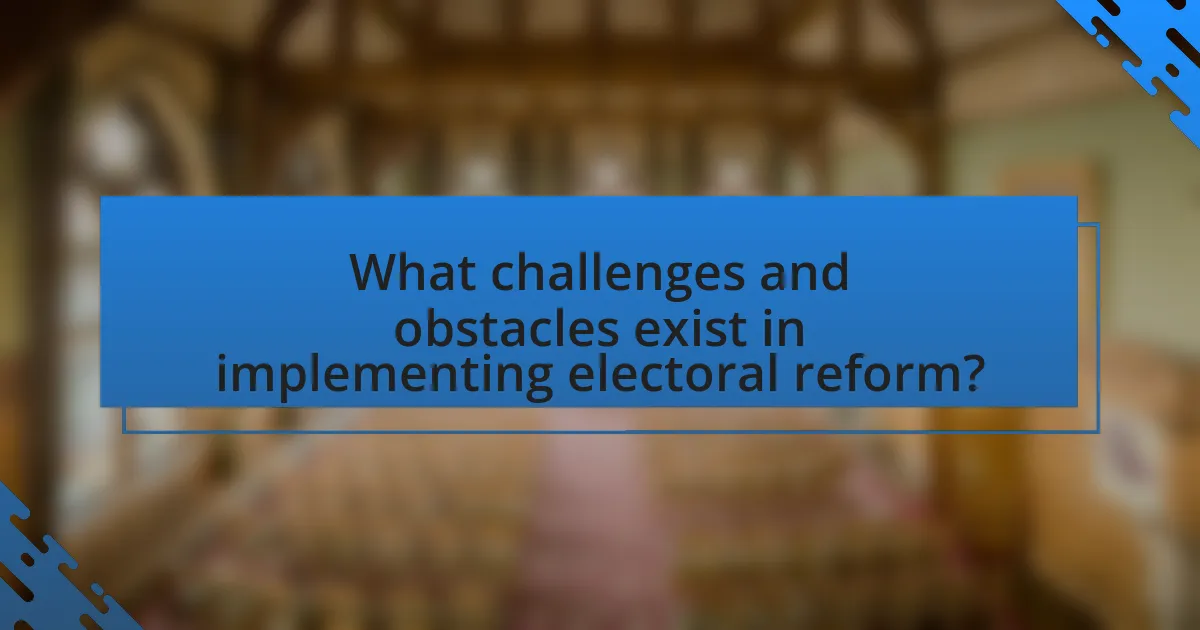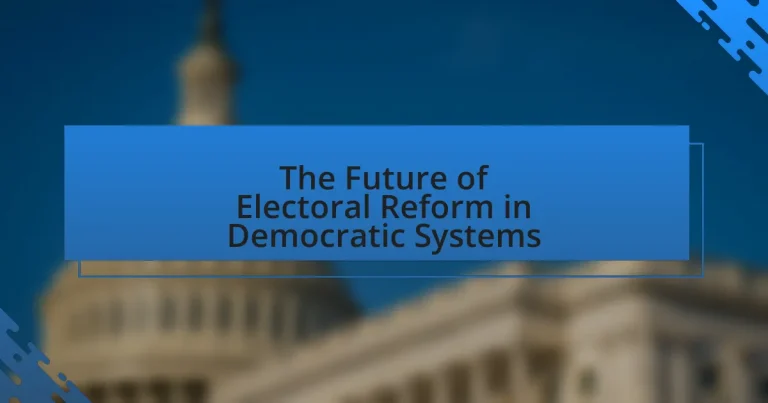The article focuses on the future of electoral reform in democratic systems, emphasizing the need for enhanced transparency, accessibility, and representation. It discusses various reform initiatives, such as ranked-choice voting and automatic voter registration, which aim to improve voter engagement and reduce disenfranchisement. Key components of electoral reform, including changes to voting systems, voter registration processes, and campaign finance regulations, are examined for their impact on democratic governance and voter participation. Additionally, the article highlights the challenges faced by current electoral systems, the role of technology, and the influence of social movements in advocating for reform, ultimately underscoring the importance of these changes for achieving fairer and more inclusive electoral processes.

What is the Future of Electoral Reform in Democratic Systems?
The future of electoral reform in democratic systems is likely to focus on enhancing transparency, accessibility, and representation. As public demand for fairer electoral processes grows, reforms such as ranked-choice voting and automatic voter registration are being considered to improve voter engagement and reduce disenfranchisement. For instance, jurisdictions that have implemented ranked-choice voting, like Maine, report increased voter satisfaction and participation rates. Additionally, the rise of technology in elections, including online voting and blockchain for security, suggests a shift towards more innovative and secure electoral practices. These trends indicate a movement towards more inclusive and efficient democratic processes.
How does electoral reform impact democratic governance?
Electoral reform significantly enhances democratic governance by improving representation, increasing voter participation, and fostering accountability. For instance, reforms such as proportional representation can lead to a more accurate reflection of the electorate’s preferences in legislative bodies, as evidenced by countries like Germany, where such systems have resulted in multi-party representation and reduced the dominance of any single party. Additionally, measures like automatic voter registration and extended voting periods have been shown to increase voter turnout, as seen in countries like Canada, where reforms led to a participation rate of over 60% in recent elections. Furthermore, electoral reforms that promote transparency and reduce corruption, such as independent electoral commissions, contribute to greater public trust in the electoral process, thereby strengthening the overall democratic framework.
What are the key components of electoral reform?
The key components of electoral reform include changes to voting systems, voter registration processes, redistricting practices, and campaign finance regulations. Voting systems may involve transitioning from first-past-the-post to ranked-choice voting, which can enhance representation. Voter registration reforms aim to simplify the process, such as implementing automatic or same-day registration, thereby increasing voter participation. Redistricting practices focus on eliminating gerrymandering to ensure fair representation, often through independent commissions. Lastly, campaign finance regulations seek to limit the influence of money in politics, promoting transparency and equity in electoral competition. These components are essential for creating a more equitable and representative democratic process.
How do these components influence voter participation?
Components such as electoral systems, voter registration processes, and accessibility measures significantly influence voter participation. Electoral systems, like proportional representation, tend to encourage higher turnout by making voters feel their votes matter, as evidenced by countries like Sweden, where turnout rates exceed 80%. Voter registration processes that are streamlined and accessible, such as same-day registration, have been shown to increase participation, as seen in states like Minnesota, which boasts some of the highest voter turnout rates in the U.S. Accessibility measures, including mail-in voting and polling place availability, directly impact participation rates; for instance, research indicates that states offering extensive mail-in voting options saw a 20% increase in voter turnout during the 2020 election.
Why is electoral reform necessary in contemporary democracies?
Electoral reform is necessary in contemporary democracies to enhance fairness, representation, and voter engagement. Current electoral systems often lead to disproportionate representation, where the distribution of seats does not reflect the actual votes cast, as seen in many first-past-the-post systems. For instance, in the 2019 Canadian federal election, the Liberal Party won a majority of seats with only 33% of the popular vote, highlighting the need for reforms that ensure every vote carries equal weight. Additionally, electoral reform can address issues such as gerrymandering, which manipulates district boundaries to favor one party over another, undermining the democratic process. By implementing reforms like ranked-choice voting or proportional representation, democracies can create a more equitable electoral landscape that encourages broader participation and trust in the political system.
What challenges do current electoral systems face?
Current electoral systems face significant challenges, including voter disenfranchisement, gerrymandering, and the influence of money in politics. Voter disenfranchisement occurs when eligible voters are unable to participate in elections due to restrictive laws or practices, which can lead to lower turnout and unequal representation. Gerrymandering, the manipulation of electoral district boundaries for political advantage, distorts the democratic process by allowing parties to entrench their power. Additionally, the influence of money in politics, particularly through campaign financing, can skew electoral outcomes in favor of wealthy candidates or interests, undermining the principle of equal representation. These challenges threaten the integrity and fairness of democratic systems, as evidenced by numerous studies highlighting their impact on voter engagement and election results.
How can reform address issues of representation?
Reform can address issues of representation by implementing proportional representation systems that ensure electoral outcomes reflect the diverse views of the electorate. For instance, countries like Germany and New Zealand have adopted mixed-member proportional systems, which allow for both direct constituency representation and proportional party representation, leading to a more accurate reflection of voter preferences. Studies show that such systems can increase voter turnout and satisfaction, as they empower minority voices and reduce the dominance of major parties, thereby enhancing democratic legitimacy.
What trends are shaping the future of electoral reform?
Trends shaping the future of electoral reform include the adoption of ranked-choice voting, increased use of technology for voting processes, and a focus on enhancing voter accessibility. Ranked-choice voting, implemented in places like Maine and New York City, allows voters to rank candidates, promoting more representative outcomes and reducing negative campaigning. The integration of technology, such as online voting and blockchain for security, aims to streamline the voting process and increase participation, as seen in various pilot programs across the United States. Additionally, reforms targeting voter accessibility, including automatic voter registration and measures to assist disabled voters, are gaining traction to ensure equitable participation in elections. These trends reflect a broader movement towards more inclusive and efficient electoral systems.
How is technology influencing electoral processes?
Technology is significantly influencing electoral processes by enhancing voter engagement, streamlining operations, and improving transparency. Digital platforms facilitate easier access to information, allowing voters to research candidates and issues more effectively. For instance, the use of online voter registration has increased participation rates; in the United States, states that implemented online registration saw a 10% increase in voter turnout. Additionally, technology enables real-time data collection and analysis, which helps electoral bodies manage logistics and respond to issues promptly. Furthermore, blockchain technology is being explored for secure voting systems, potentially reducing fraud and increasing public trust in election outcomes.
What role do social movements play in advocating for reform?
Social movements play a crucial role in advocating for reform by mobilizing public support, raising awareness, and influencing policy changes. These movements often highlight social injustices and demand changes in legislation or practices, as seen in the civil rights movement, which successfully led to the Voting Rights Act of 1965, ensuring greater electoral access for marginalized groups. By organizing protests, campaigns, and grassroots efforts, social movements create pressure on political leaders and institutions to address specific issues, thereby facilitating reform in democratic systems.

What are the potential benefits of electoral reform?
Electoral reform can enhance democratic representation and improve voter engagement. By implementing systems such as proportional representation, electoral reform can ensure that minority voices are heard, leading to a more inclusive political landscape. For instance, countries like Germany and New Zealand have adopted proportional representation, resulting in a broader spectrum of political parties and perspectives in their legislatures. Additionally, electoral reform can reduce gerrymandering, which distorts electoral outcomes, thereby fostering fairer competition among candidates. Studies have shown that regions with reformed electoral systems often experience higher voter turnout, indicating increased public interest and trust in the electoral process.
How can electoral reform enhance voter engagement?
Electoral reform can enhance voter engagement by implementing measures such as automatic voter registration, ranked-choice voting, and reducing barriers to participation. These reforms simplify the voting process, making it more accessible and appealing to a broader demographic. For instance, studies show that states with automatic voter registration have seen increases in voter turnout by as much as 10% compared to those without such measures. Additionally, ranked-choice voting encourages more diverse candidate representation, which can motivate voters to participate when they feel their preferences are better reflected in the electoral process.
What methods can be employed to increase voter turnout?
To increase voter turnout, implementing measures such as automatic voter registration, same-day registration, and targeted outreach campaigns can be effective. Automatic voter registration simplifies the process by registering individuals when they interact with government agencies, which has been shown to increase participation rates significantly. For instance, states like Oregon have reported a 10% increase in voter turnout since adopting this method. Same-day registration allows voters to register and cast their ballots on the same day, which has been linked to higher turnout, particularly among young and first-time voters. Additionally, targeted outreach campaigns that focus on underrepresented communities can enhance engagement; research indicates that personalized communication strategies can boost turnout by as much as 5-10%.
How does reform improve the electoral experience for citizens?
Reform improves the electoral experience for citizens by enhancing accessibility, transparency, and fairness in the voting process. For instance, implementing measures such as automatic voter registration and extended voting hours increases participation by making it easier for citizens to vote. Additionally, reforms like ranked-choice voting can lead to more representative outcomes, allowing voters to express preferences more fully. Evidence from jurisdictions that have adopted these reforms shows increased voter satisfaction and engagement, as seen in studies conducted by the Brennan Center for Justice, which highlight that reforms lead to higher turnout rates and a more informed electorate.
What impact does electoral reform have on political representation?
Electoral reform significantly enhances political representation by creating more equitable and inclusive electoral systems. For instance, reforms such as proportional representation allow for a broader spectrum of political parties to gain seats in legislatures, reflecting the diverse views of the electorate. Evidence from countries like Germany and New Zealand shows that these systems lead to higher voter turnout and increased representation of minority groups, including women and ethnic minorities. In contrast, winner-takes-all systems often marginalize smaller parties and underrepresent certain demographics, leading to a disconnect between elected officials and the electorate’s preferences. Thus, electoral reform directly influences the quality and inclusiveness of political representation in democratic systems.
How can reform lead to more equitable representation?
Reform can lead to more equitable representation by implementing systems such as proportional representation, which ensures that political parties gain seats in proportion to the number of votes they receive. This method contrasts with winner-takes-all systems, where a single candidate can dominate an election, often marginalizing minority voices. For instance, countries like Germany and New Zealand have adopted proportional representation, resulting in a more diverse legislative body that reflects the electorate’s varied demographics. Studies show that such reforms can increase the representation of women and minority groups in government, as evidenced by New Zealand’s increase in female parliamentary representation from 27% to 48% after adopting a mixed-member proportional system in 1996.
What examples exist of successful representation changes due to reform?
Successful representation changes due to reform include the implementation of proportional representation in countries like New Zealand and Germany. In New Zealand, the Electoral Reform Act of 1993 transitioned from a first-past-the-post system to a mixed-member proportional system, resulting in a more diverse parliament that better reflects the electorate’s preferences. This reform led to increased representation for smaller parties, enhancing political pluralism. Similarly, Germany’s adoption of a mixed-member proportional system in 1949 has allowed for a balanced representation of both major and minor parties, ensuring that the composition of the Bundestag mirrors the votes cast by the public. These reforms have been validated by studies showing increased voter satisfaction and engagement in both countries.

What challenges and obstacles exist in implementing electoral reform?
Implementing electoral reform faces significant challenges and obstacles, primarily including political resistance, public apathy, and logistical complexities. Political resistance often arises from established parties that may fear losing power or influence, as reforms can disrupt the status quo. For instance, in the United States, attempts to reform gerrymandering have met with opposition from both major political parties, which benefit from current districting practices. Public apathy can hinder reform efforts, as citizens may lack awareness or interest in the electoral process, leading to low engagement in advocacy for change. Additionally, logistical complexities, such as the need for new voting technologies or changes in voter registration processes, can create barriers to implementation. Historical examples, such as the challenges faced during the Voting Rights Act implementation in the 1960s, illustrate how these obstacles can delay or derail reform initiatives.
What resistance do reform initiatives typically face?
Reform initiatives typically face resistance from entrenched political interests, public skepticism, and institutional inertia. Entrenched political interests often oppose reforms that threaten their power or influence, as seen in various electoral systems where incumbents resist changes that could disrupt their electoral advantages. Public skepticism arises from a lack of trust in the motives behind reforms, often fueled by misinformation or past failures, which can hinder broad support for new initiatives. Institutional inertia, characterized by the reluctance of established systems to change, can slow down or block reform efforts, as seen in numerous democratic systems where existing frameworks are deeply embedded.
How do political parties react to proposed reforms?
Political parties typically react to proposed reforms with a spectrum of responses that align with their ideological positions and electoral strategies. For instance, parties may support reforms that enhance their electoral prospects or align with their core values, such as advocating for proportional representation to increase their influence. Conversely, they may oppose reforms perceived as threatening their power or electoral viability, such as changes that could dilute their voter base or introduce competitive challenges. Historical examples include the resistance of established parties to campaign finance reforms that limit their funding sources, as seen in the United States with the Bipartisan Campaign Reform Act of 2002, which faced significant pushback from major political entities. This pattern of support or opposition is often influenced by public opinion, party platforms, and the potential impact on future elections.
What role does public opinion play in the reform process?
Public opinion significantly influences the reform process by shaping policymakers’ decisions and priorities. When a substantial portion of the public supports specific reforms, elected officials are more likely to advocate for and implement those changes to align with constituents’ preferences. For instance, surveys have shown that public support for electoral reforms, such as ranked-choice voting, can lead to legislative action, as seen in various states where reforms were enacted following widespread public backing. This correlation between public sentiment and reform initiatives underscores the importance of public opinion in driving democratic changes.
How can successful electoral reform be achieved?
Successful electoral reform can be achieved through a combination of inclusive stakeholder engagement, transparent processes, and evidence-based policy design. Engaging a diverse range of stakeholders, including political parties, civil society, and the electorate, ensures that the reform reflects the needs and preferences of the population. Transparency in the reform process builds public trust and encourages participation, while evidence-based policy design utilizes data and research to inform decisions, increasing the likelihood of effective outcomes. Historical examples, such as the electoral reforms in New Zealand in the 1990s, demonstrate that these elements can lead to more representative and fair electoral systems, resulting in increased voter satisfaction and participation.
What strategies have proven effective in past reform efforts?
Effective strategies in past reform efforts include stakeholder engagement, incremental changes, and evidence-based policymaking. Stakeholder engagement fosters collaboration among diverse groups, ensuring that reforms reflect the needs of the community, as seen in the successful implementation of the 1994 South African electoral reforms, which involved extensive public consultations. Incremental changes allow for adjustments based on feedback and outcomes, exemplified by New Zealand’s gradual shift to a mixed-member proportional representation system in the 1990s, which improved voter satisfaction and representation. Evidence-based policymaking relies on data and research to guide decisions, demonstrated by the use of electoral studies in Canada to inform reforms in the electoral process, leading to increased voter turnout and trust in the system. These strategies have consistently shown positive results in enhancing democratic processes and electoral integrity.
How can stakeholders collaborate to promote reform?
Stakeholders can collaborate to promote reform by establishing coalitions that unite diverse interests, facilitating dialogue, and sharing resources. For instance, in the context of electoral reform, stakeholders such as government officials, civil society organizations, and political parties can come together to create a shared agenda that addresses common goals, such as increasing voter participation or enhancing transparency in the electoral process. Research shows that collaborative efforts, like the “Electoral Reform Coalition” in Canada, have successfully influenced policy changes by leveraging collective expertise and public support, demonstrating that unified action can lead to significant reforms in democratic systems.
What best practices should be considered for future electoral reforms?
Future electoral reforms should prioritize transparency, accessibility, and security to enhance democratic processes. Transparency can be achieved through open data initiatives that allow public scrutiny of electoral processes, as seen in countries like Canada, where election data is made publicly available. Accessibility involves ensuring that all eligible voters can easily participate, which can be supported by implementing automatic voter registration and expanding voting methods, such as mail-in ballots, as demonstrated in several U.S. states during the 2020 election. Security measures, including the use of paper ballots and risk-limiting audits, have been shown to increase voter confidence and integrity in elections, as evidenced by practices adopted in countries like Germany. These best practices collectively contribute to a more robust electoral system that reflects the will of the people.
How can lessons from past reforms guide future initiatives?
Lessons from past reforms can guide future initiatives by providing evidence-based insights into what strategies have been effective or ineffective in achieving desired outcomes. Historical examples, such as the Voting Rights Act of 1965, demonstrate that targeted reforms can significantly enhance voter participation and equity in electoral processes. Analyzing the successes and failures of previous reforms allows policymakers to identify best practices, avoid repeating mistakes, and tailor new initiatives to address contemporary challenges in democratic systems. For instance, the implementation of ranked-choice voting in various jurisdictions has shown to reduce negative campaigning and increase voter satisfaction, offering a model for future electoral reforms.
What are the key factors for ensuring sustainable reform outcomes?
Key factors for ensuring sustainable reform outcomes include stakeholder engagement, clear objectives, and adaptive implementation strategies. Stakeholder engagement ensures that diverse perspectives are considered, fostering buy-in and support for reforms. Clear objectives provide a focused direction, allowing for measurable progress and accountability. Adaptive implementation strategies enable reforms to be adjusted based on feedback and changing circumstances, enhancing their effectiveness. Research indicates that successful electoral reforms often incorporate these elements, leading to more resilient and enduring outcomes in democratic systems.




